THE COOKBOOK TEST #101: MASTERING THE ART OF FRENCH COOKING
INSTALLMENT #101 (FREE) PANEL DISCUSSION / PRECISE AND DIRECT / EGGS, SCRAMBLED / CHICKEN, ROASTED / ASPARAGUS, BOILED / CAKE, DELICIOUS
Dear Readers,
This week’s book is a bit of an old chestnut: Mastering the Art of French Cooking, by Julia Child (with Louisette Bertholle and Simone Beck.) Originally published in 1961, this is the book that launched the foundational TV cook’s illustrious career, which culminated, of course, with the release of the 2009 film Julie and Julia. [1]
My own relationship with Child has been cordial but distant. As long as I’ve been alive, she’s been there: popular, cheerful, competent but self-effacing. When I moved to Cambridge, Mass. in 1999, one of the first interesting rumors I heard was that not only was Child listed in the phone book, if you called her with a cooking-related question she’d do her best to help. I never had the never or cheek to try it out, but it fit the image: grand but accessible, magisterial but goofy.
Then this summer I got invited to moderate a panel of notable chefs for the upcoming Julia Child exhibit at the Minnesota History Center, and I took a sudden interest. My abstract awareness of Child needed to get considerably more concrete.
It turns out that you can get a used copy of Mastering the Art of French Cooking online for about $4, or 1/10th the cover price. Considering the book’s reputation, this is absurdly cheap. But maybe it fails to live up to the hype?
at your service,
James
MASTERING THE ART OF FRENCH COOKING
JULIA CHILD, LOUISETTE BERTHOLLE, AND SIMONE BECK
KNOPF | 1961 | $40
Just kidding, of course it lives up to the hype. Here, for example, is a quote from the introduction of the 40-year anniversary edition of the book, wherein Child recalls what American food used to be like:
I cannot forget one ladies’ lunch back in the 1950s. Our hostess proudly led us to our seats around a nicely appointed table where we each sat down to a pretty china plate upon which stood an upright, somewhat phallic-shaped molded aspic holding in suspension diced green grapes, diced marshmallows, and diced bananas. Surrounded lavishly but neatly with whipped cream, this lovingly constructed edifice rested on several leaves of iceberg lettuce far too small to hide anything under. After the main course, and grandly brought in to the acclaim of the guests, was a very large and high coconut cake, almost certainly made from a cake mix and, again, constructed with utmost care. That was a quite typical, dressy example of the period, created earnestly and with the most generous intentions.
That’s the essence of Child: Observant, hilarious, candid, generous, precise. These same qualities shine throughout Mastering the Art of French Cooking. The book is more than a mere collection of recipes - it’s a collection of techniques, tutorials, gear guides, diagrams, and ingredient gazetteers. The writing is lucid, no-nonsense, lively, clear, and comprehensive, without redundancy. It’s a triumph and the time (the early ‘60s) and the topic (accessible French cuisine) combined to make it a lasting masterpiece.
Moreover: this book is FUN AS HELL to cook out of. I tried four recipes (six if you count sauces) and while none of them were grueling or fussy, they were intense. Cooking them felt like playing tennis - constant iterations, seasoning, basting, whipping, and fussing. There was an intensity to the effort that came through on the plate.
OEUFS BROUILLÉS AU FROMAGE
Scrambled eggs have become a bit of a thing in our house. I struggle to cook them well, while my son Joe (age 12) has a deft hand and gets them right every time.
I had hoped the rich, butter-forward, cheese-laden eggs from Mastering would turn the tide, but the French ideal for scrambled eggs is apparently closer to custard than our household can handle - they came out rich, loose, and delicate. Ultimately we’re going to stick with the status quo, although I enjoyed the change of pace and found the recipe clear and well-written.
POULET ROTI
Like scrambled eggs, roast chicken is apparently dead simple, insultingly straightforward, and - yet - bizarrely easy to mess up. As simple as it is to put a chicken in an oven, it’s equally easy to end up with a bird that’s dry, unevenly cooked and/or downright boring to eat.
The Julia Child chicken I made required a bit of babysitting - trussing [2], turning, salting, basting - and demanded a pan sauce to boot. The result was a delicious dinner, with tender, full-flavored, moist meat that almost didn’t need the lovely savory gravy that took a few minutes to whip up as the cooked chicken rested.
In short: an utterly classic and classy rendition of an all-time favorite dish.
ROAST CHICKEN
3-4 pound whole chicken
¼ tsp salt
2 Tbsp softened butter
For basting:
2 Tbsp melted butter
1 Tbsp good olive oil
For pan sauce:
½ Tbsp minced shallot
1 cup chicken stock
Salt and pepper
1-2 Tbsp softened butter
Estimated roasting time for a 3-4 pound chicken: 70-80 minutes.
Preheat oven to 425 F.
Sprinkle the inside of the chicken with ¼ tsp salt and smear in 1 Tbsp butter. Truss the chicken, dry it, and rub skin with remaining 1 Tbsp butter.
Place chicken breast side up in roasting pan with vegetables surrounding it. Allow chicken to brown lightly for 15 minutes, turning it on the left side after 5 minutes, and on the right side for the last 5 minutes, basting in with the butter and oil after each turn.
Reduce oven to 350 F. Leave chicken on its side, and baste every 10-15 minutes, using fat in the pan when butter and oil are exhausted. Halfway through estimated roasting time, salt the chicken with ¼ tsp salt and turn it on its other side. Continue basting. Fifteen minutes before end of roasting time, salt again with ¼ tsp salt and turn chicken breast side up. Continue basting, and finish when internal chicken breast temperature hits 165 F.
When done, discard trussing strings and set chicken on a hot platter at room temperature for 5-10 minutes before carving. While waiting, make a pan sauce:
Remove vegetables and all but 2 Tbsp of fat from the pan. Stir in minced shallots and cook over medium heat for 1 minute. Add stock and boil rapidly over high heat, scraping pan with wooden spoon. Let liquid reduce to about ½ cup, then season with salt and pepper and remove from heat. Swirl in 1-2 Tbsp butter and serve with chicken.
ASPERGES AU NATUREL AVEC BEURRE AU CITRON
I’m a big fan of asparagus broiled or grilled with olive oil, salt, and pepper. But boiled asparagus with lemon butter sounded plausible too, so I gave it a shot as a side dish.
The result: quite delicious. As much as I missed the char from the burning coal, I dug the creamy citrus intensity of the beurre au citron and appreciated not having to hassle with either a smokey grill or a super-hot broiler. And as it turned out, that sauce worked quite nicely with the roast chicken as well.
BOILED ASPARAGUS WITH LEMON BUTTER
1 bundle of asparagus
Lemon butter:
¼ cup lemon juice
⅛ tsp salt
Pinch of white pepper
1 stick (4 oz.) of butter, cut into 8 pieces
2-3 Tbsp hot stock or water
Boil a large pot of salted water. Trim asparagus by removing tough bases and then tie into a bundle. Place bundle into pot and boil for 12-15 minutes, until thickest part of asparagus is tender.
Make sauce: boil lemon juice with salt and pepper down to about 1 Tbsp. Remove from heat and beat in 2 pieces of butter. Set over very low heat and beat in remaining butter one piece at a time, until you have a thick, creamy sauce. Remove from heat. Just before serving, beat in hot liquid by driblets to warm the sauce. Correct seasoning and serve in a sauceboat.
REINE DE SABA
I felt obligated to make the almond-chocolate cake that Child described as her “all-time favorite.” And while I’m not sure I nailed it - I have a feeling I over-mixed the egg whites, leading to a denser, flatter cake than intended - the end result was terrific. The cake was rich, deeply flavored, chocolate-forward and delightfully simple without being boring. Rum and almond provided the supporting notes to let the cocoa soar.
QUEEN OF SHEBA CAKE
4 oz. of semi-sweet chocolate
2 Tbsp dark rum or coffee
One stick (4 oz.) of butter, softened
⅔ cup sugar
3 egg yolks
3 egg whites
Pinch of salt
1 Tbsp sugar
⅓ cup almond flour
¼ tsp almond extract
½ cup cake flour
Preheat oven to 350 F.
Butter and flour a 8” cake pan of at least 2” depth. Use a double boiler to gently melt and combine the chocolate and rum (or coffee) while stirring gently and remove from heat.
Cream the butter and sugar in a stand mixer until they form a pale yellow, fluffy mixture.
Beat in the egg yolks until well blended.
Beat the egg whites and salt in another bowl until soft peaks are formed; sprinkle on the sugar and beat until stiff peaks are formed.
Blend the melted chocolate into the butter and sugar mixture, then stir in the almond flour and extract. Mix in 1/4th of the beaten egg whites to lighten the batter, then fold in the remaining whites and cake flour in two or three alternating batches. Do not overmix.
Turn the batter into the cake pan, and bake for about 25 minutes, until center shakes only a tiny bit and a skewer comes out mostly clean with a bit of oil.
Let cake cool in pan for 10 minutes, run a knife around the edge, and reverse cake onto cooling rack. Let it cool for an hour and then ice it.
CHOCOLATE ICING
2 ounces of semi-sweet chocolate
2 Tbsp rum or coffee
5-6 Tbsp butter
Place ice cubes in a bowl of water. Place chocolate and rum or coffee in double boiler and melt while stirring until smooth. Remove from heat, and stirring butter one tablespoon at a time. Then beat over ice water until chocolate mixture has cooled to spreading consistency. Spread over cake with knife or spatula.
MASTERING THE ART OF FRENCH COOKING
(***BUY IT*** / BORROW IT / SKIP IT / SCRAP IT)
Mastering the Art of French Cooking is considered an all-time masterwork, and, upon review, that verdict absolutely holds water. Pick up a used copy for a few books, and allow yourself to be enriched and spiritually embiggened.
FOOTNOTES
[1] I kid, of course, Julie and Julia was mostly unwatchable.
[2] Yes, I know the trussing isn’t very good. But it was ultimately good enough, as the chicken did cook thoroughly and evenly. You’ll just have to trusst me on that.


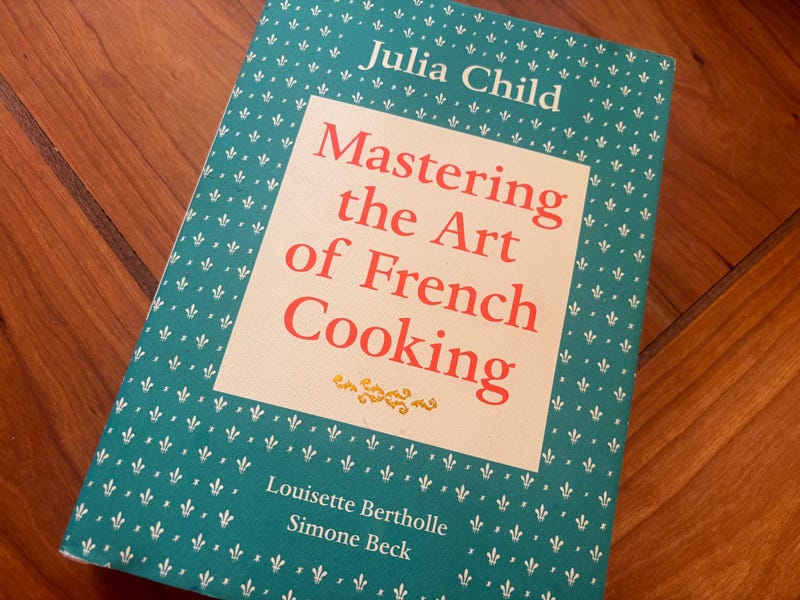
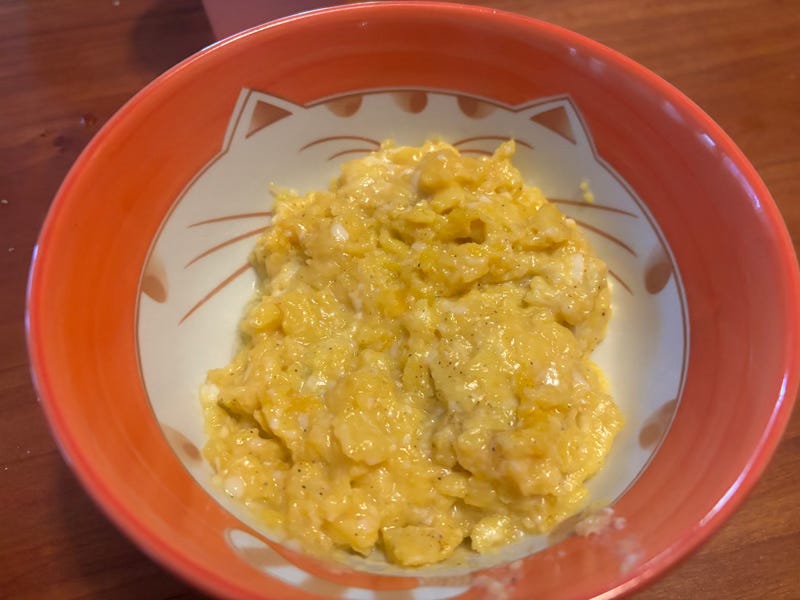
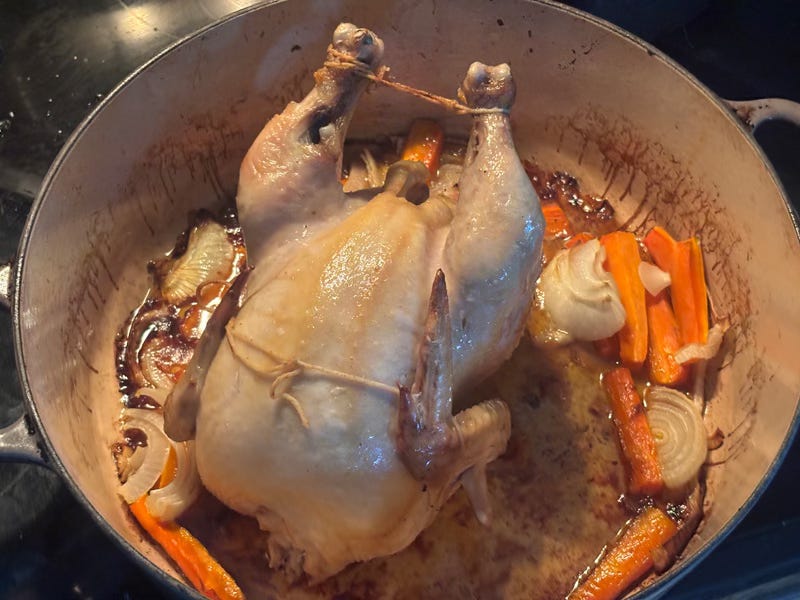

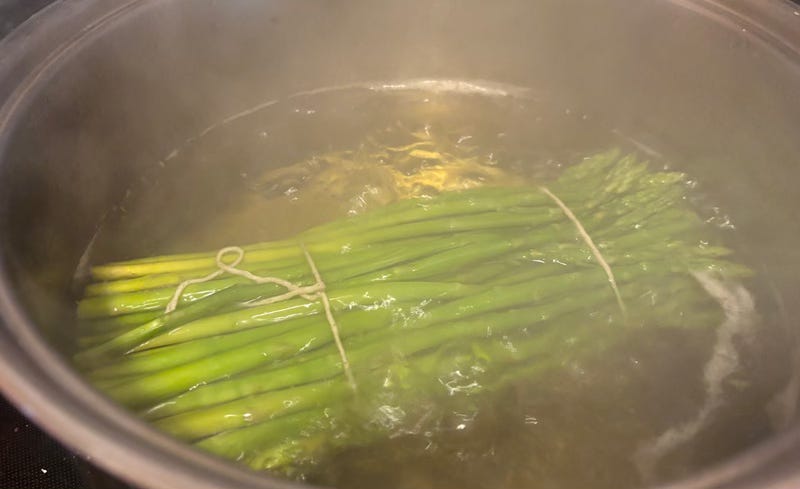
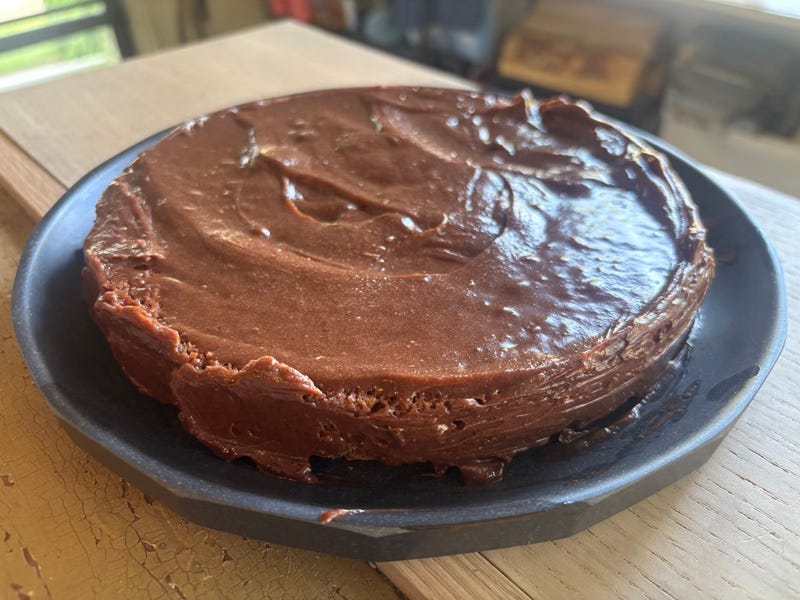
Good